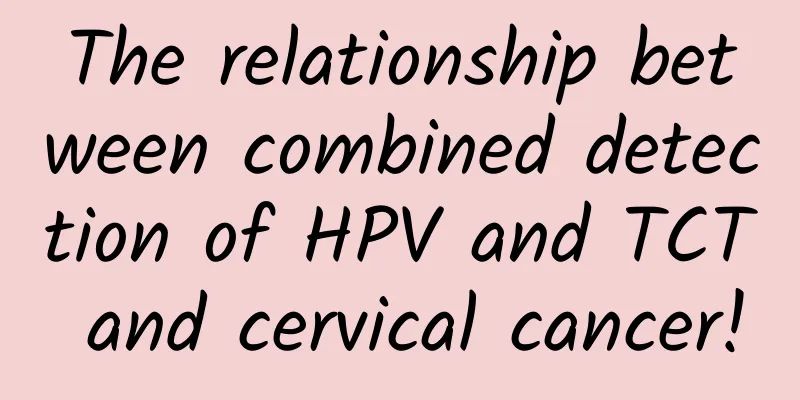The relationship between combined detection of HPV and TCT and cervical cancer!

|
When it comes to cancer, everyone changes color and feels like the sky is falling. In fact, with the development of science and technology and the application of new medical technologies, many cancers and tumors can be cured as long as they are discovered in the early stage. For example, the cervical cancer we are talking about now, as well as thyroid cancer, breast cancer, rectal cancer, and even lung cancer, liver cancer, etc., as long as they are discovered in the early stage, the cancerous tissue can be removed through surgery, and even chemotherapy, radiotherapy and other drug treatments are not needed. So, how can we detect it early? Let's talk about the "relationship between HPV and TCT combined detection and cervical cancer." HPV is the abbreviation of human papillomavirus, a small DNA virus, and the only confirmed carcinogenic virus in the onset of human tumors. It has many types, and only a few types have been studied to cause cervical cancer. At present, there are 12 types of high-risk viruses that may cause cancer in Chinese people, including 16, 18, 31, 33, 35, 39, 45, 51, 52, 56, 58, and 59. However, infection with the HPV virus does not necessarily cause cancer. Generally, 5%-10% of high-risk HPV infections eventually become persistent infections, and less than 5% eventually develop into cervical cancer. It takes 8 to 10 years from HPV infection to cervical cancer. Even if infected with HPV, most people can turn negative through treatment and changes in lifestyle. Only 5% of persistent infections may develop into cervical cancer. So for infected people. In addition to detecting whether HPV has turned negative, it is also necessary to combine TCT testing. TCT is a liquid-based ultra-thin cytology smear , which is made by scraping cervical tissue into an ultra-thin smear. After a series of staining, it is observed whether the cells have become cancerous. Once the cells show signs of cancer, they should be treated early to remove the cancerous tissue, and then supplemented with resistance enhancement and antiviral treatment, and they can be cured. So, which groups of people need early screening? 1. For women over 21 years old or who have had sexual activity for more than 3 years, if the test is negative once a year for three consecutive years, they only need to undergo cytology and HPV combined screening every 3 years. 2. For people aged 30-65, combined cytology and HPV testing every 5 years is recommended. For those with normal previous screening results, further screening is not recommended after the age of 65. 3. Patients who are HPV positive for the first time need to be treated, especially high-risk patients. TCT must be screened together. If TCT is normal, HPV and TCT combined screening should be performed every six months until HPV turns negative. If HPV is continuously positive and TCT is abnormal, treatment should be carried out according to the doctor's advice. In short, HPV positivity is not scary, but it should not be taken lightly. Early screening, early diagnosis, and early treatment can protect women’s health! (Author: Zhang Mingjun, PhD candidate and director of the laboratory department of Jiulongpo District People's Hospital, Chongqing) |
<<: Are all low-fat foods healthy foods?
Recommend
What is the ointment for vulvar itching?
Women often experience vulvar itching, which can ...
Early symptoms and treatment methods, what patients with diabetic foot need to know!
Author: Cui Lei, Chief Physician, Beijing Century...
Why is grapefruit sour and bitter? When is grapefruit eaten?
Grapefruit is the mature fruit of the evergreen t...
How to perform missed abortion surgery?
In today's society, abortion has become a ver...
Does the decoration style need to consider the area of the house? What should the decoration style mainly look at?
We all know that when decorating a house, the fir...
What are the signs of pregnancy on the ninth day after ovulation?
Everyone knows that if you want to get pregnant q...
Medical abortion process diagram
When a pregnant mother has to end the life of her...
Female vulvar leukoplakia
Vulvar leukoplakia is a relatively common disease...
At what age do women usually reach menopause?
Menstruation is a unique physiological phenomenon...
Kidney disease can also cause high blood pressure, don’t believe it!
Author: Cai Jun, Chief Physician, Fuwai Hospital,...
Abnormal symptoms of scanty menstruation after cesarean section
Nowadays, many women choose cesarean section as a...
Can I take a shower one month after a caesarean section?
Caesarean section is a common way of delivery in ...
Missing menstruation for two consecutive months
Irregular menstruation is a very common condition...
What causes stomach pain after abortion?
If a woman chooses to have an abortion, she must ...
After myopia surgery, here are 8 things you need to pay attention to in daily care!
Many of my myopic friends All choose to use surge...









